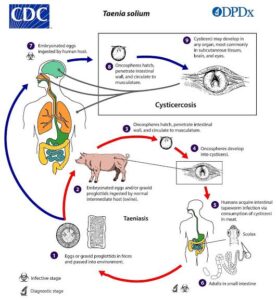Back to: ZOOLOGY 300 Level
WELCOME TO CLASS!
You’ve been showing a strong, steady spirit on this learning journey, and today’s topic is one that will open your eyes even more to the brilliance of nature—anatomy and parasitic adaptations.
Now, you’ve probably heard about parasites—maybe from biology class, or even from local stories about people getting worms after drinking untreated water. But beyond the health warnings, parasites are some of the most cleverly adapted animals on earth. Their survival strategies are so impressive that if they weren’t so harmful, they’d almost be admirable!
Anatomy And Parasitic Adaptations
Let’s look closely at how parasites are designed, inside and out, to live off other organisms—and do it successfully.

Understanding Parasites and Parasitism
A parasite is an organism that lives on or inside another organism (called the host) and benefits by getting nutrients at the host’s expense. Unlike predators, parasites don’t kill their host immediately—they need the host to stay alive so they can keep feeding.
You can think of it like someone entering your house, eating your food, sleeping in your bed, and leaving you weak—but without doing the house chores or paying rent!
Anatomy of Parasites
To survive this lifestyle, parasites have unique body features (anatomy) that make them masters of their craft. Let’s look at some examples:
- Flatworms (like tapeworms):
These are found in the intestines of humans and animals. Their bodies are flat and long, which gives them a large surface area to absorb nutrients directly from the host’s gut. They don’t even have a digestive system—they just soak in food!
They also have hooks and suckers on their heads (called the scolex) to anchor themselves to the intestinal wall—so even when food is moving through the gut, they don’t get flushed out. - Roundworms (like Ascaris):
These worms live in the intestines too, but unlike flatworms, they have a complete digestive system. Their bodies are smooth, cylindrical, and covered with a tough cuticle that protects them from the host’s digestive juices. - Blood parasites (like Plasmodium):
Plasmodium is the parasite that causes malaria. It’s carried by mosquitoes and lives in human blood. It hides inside red blood cells and changes its surface proteins often, which makes it hard for the immune system to detect and fight it.
Parasitic Adaptations: How Parasites Survive and Thrive
Parasites don’t survive by chance—they are highly adapted for their lifestyle. Here are some key adaptations:
- High reproductive rate: Parasites produce many eggs or offspring because most won’t survive to infect a host. A single tapeworm can release thousands of eggs into the host’s faeces daily.
- Simple or no digestive system: Many parasites live in environments where food is already digested. So, they absorb nutrients through their body surface instead of wasting energy on breaking food down themselves.
- Protective body coverings: Many internal parasites have thick, resistant outer layers to survive stomach acid, enzymes, and other host defences.
- Modified sensory and locomotory organs: Many parasites have reduced sense organs, since they don’t need to find food—they just absorb it. Others have attachment organs (like hooks, suckers, or clamps) to hold onto the host.
- Complex life cycles: Many parasites have more than one host during their life, such as Plasmodium (which needs both mosquitoes and humans). These complex cycles help them survive in different environments.

Real-Life Nigerian Example
Many children in rural parts of Nigeria suffer from soil-transmitted helminths—worms like hookworms and roundworms. These parasites enter the body through bare feet or dirty food and settle in the intestines. Their anatomy allows them to feed on blood or digested food, making children weak, tired, and prone to illness.
That’s why basic hygiene and proper footwear can make a big difference in preventing infections.
Summary
- Parasites live on or in other organisms and benefit at the host’s expense.
- Their anatomy includes special adaptations like hooks, suckers, high reproductive ability, and protective body coverings.
- Parasites often lack complex systems because they rely on the host’s resources.
- Understanding these features helps scientists control and prevent parasitic diseases.
Evaluation
- What is the difference between a parasite and a predator?
- Describe two anatomical adaptations found in tapeworms.
- Why do parasites produce so many offspring?
- How does Plasmodium avoid being attacked by the host’s immune system?
- Mention one reason why roundworms can survive in the human gut.
You’ve just uncovered the hidden strategies that parasites use to survive. The more we understand them, the better we can protect ourselves and create a healthier world. Let’s keep going—you’re becoming a true Zoologist-in-the-making!
